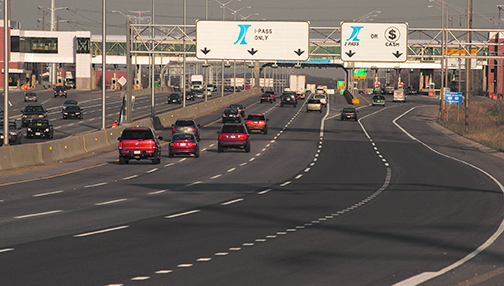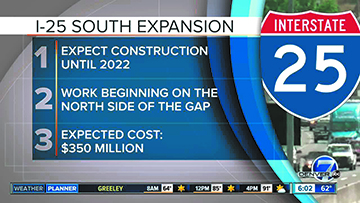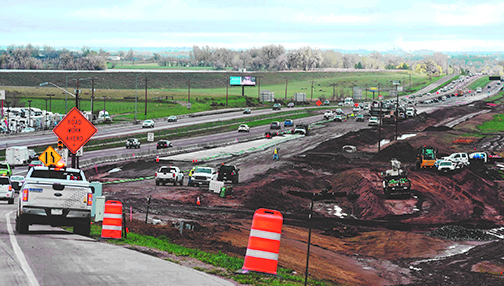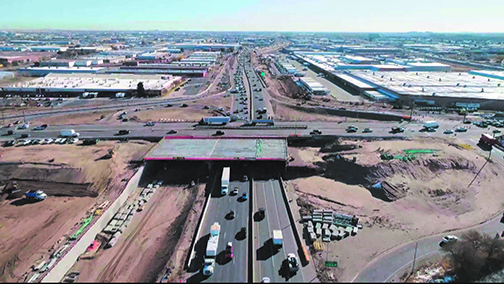Part III Of A III Part Series
by Charles C. Bonniwell
The future for the average motorist in Colorado is going to be bleak according to insiders at the Colorado Department of Transportation (CDOT) which is the state agency in charge of the transportation needs of the people of Colorado. In a 99-page study provided in December by CDOT to the Colorado Legislature, the department claimed to need $14 million to $84 million annually in increased fees with Executive Director Shoshana Lew stating in a cover letter that the state’s “transportation funding is insufficient and outdated.”

The requested fees increase would in fact be of little help to the embattled state agency which has little desire or funding to save the failing roads system in Colorado. Although seldom starkly expressed, Lew’s plan is to make driving in Colorado so painful that many average Coloradans will abandon their cars in favor of a public transit alternative. She understands the inconvenience and unpleasantness of Colorado’s public transportation system and that the state’s most affluent residents will likely want to retain the convenience of their own automobiles. Under the radar CDOT is creating a two tier system — revenue or “Lexus” lanes for those who can afford it and massive traffic congestion for the general public.
Four major projects in and around Denver demonstrate this new approach:
• $1.3 billion 10 mile Central I-70 Project in Denver;
• $500 million I-25 North Expansion Project north of Denver;
• $350 million 18 mile I-25 GAP Project south of Denver; and
• $226 million 12.5-mile C-470 Project southwest of Denver.
Many motorists are outraged when they learn that billions of dollars in expenditures and massive construction inconveniences will not provide a single additional lane of road for the average motorist. CDOT effectively has slammed shut state firms from the ability to bid on the projects so almost all projects are done by massive out-of-state conglomerates at inflated prices. The following four massive projects reveal what is in store for the people of the state.
C-470 Project

The 12.5 miles between Wadsworth and I-25 in Douglas County is one of the busiest stretches of roads in Colorado with over 100,000 cars traveling it every day. The $226 million spent is solely for Lexus lanes while the general public will be forced to use the same two lanes east and west. CDOT did not have the funds, and did not want to ask the public for the borrowing as required by the Taxpayers Bill of Rights (TABOR). It therefore set up an enterprise fund titled The High Performance Transportation Enterprise (HPTE) which issued $161.7 million in revenue bonds and borrowed $106.9 million in loans from federal sources. The revenue from the Lexus lanes will go to pay back the loans, but even after the payoff, decades in the future, they are not expected to ever open the lanes to nonpaying drivers.
CDOT expects by 2030 the car usage will jump to 140,000 cars daily making travel ever more highly congested and allowing CDOT to charge ever increasing premium prices for their Lexus lanes.
The contract to build the 12.5 miles of road was not low bid (LB) but awarded on a design build (DB) concept to a joint venture of Flatiron Construction (a subsidiary of the massive German conglomerate HOCHTIEF) and AECOM, a large engineering firm out of Los Angeles. It is one of the few large projects in Colorado not awarded to the virtual duopoly of Kraemer North America LLC (a subsidiary of the Japanese construction giant Obayashi Corporation), and Kiewit Corporation, a Fortune 500 construction firm based in Omaha, Nebraska.
The project has been in constant delays and CDOT sent a letter of default to Flatiron/AECOM who in turn indicated the failures have been due to CDOT’s gross incompetence and the agency’s ongoing effort to try to blame everyone else for its internal problems. The latest delayed opening projection is in June of 2021.
I-25 Gap Project

If you are traveling south on I-25 after completing the 12.5 miles of C-470 you will need to take your wallet out quickly enough to travel the 18 miles from Monument to Castle Rock in more Lexus lanes. That stretch of road is two lanes each way and CDOT says it is so dangerous that two State Patrol officers have recently died in accidents using the road. Of course, it is not really clear why it would be any less dangerous to the average motorist who doesn’t get to use the one additional Lexus lane each way other than some minor road shoulder expansion on existing lanes. The Gap Project will cost $350 million with the state providing $250 million, $65 million from the federal government, $35 million from local governments including El Paso and Douglas counties. Westword has been chronicling the traffic nightmares imposed on the average motorist in articles titled “Traffic Nightmare Closures Come to I-25.” Few are aware the only beneficiary of the money and the traffic are to be the affluent who are willing to pay the fees for the Lexus lanes and political outrage will occur when the public does find out.
This project was awarded by CDOT to Kraemer not on a competitive bid process but by Construction Management/General Contractor method (CMGC) by which over 80 percent of such projects are awarded to either Kraemer or Kiewit. This project is also haunted by numerous delays and is now not expected to be finished until 2022. As with all CDOT projects CDOT blames the contractor and the contractor blames CDOT.
I-25 North Express Lanes Mead To Fort Collins

If you head north instead of south on I-25 after leaving C-470 you cannot escape the Lexus lanes. The Mead to Fort Collins project was originally for 13.5 miles for $250 million and awarded to Kraemer. Later when an additional $250 to $300 million of funding was located another 4.5 miles was added. Without even pretending to look for competitive bids CDOT simply gave it to their friends at Kraemer, based on a so-called “change order.”
Central I-70 Project

The most controversial and costly of all of the recent CDOT projects is the 10 mile stretch of I-70 from Chambers Road to I-25 which comes in at a whopping $1.3 billion dollars. For that money, in the end all you get is a Lexus lane going each way. The road, instead of going over the neighborhoods of Elyria and Swansea with a viaduct, goes down to the neighborhoods and then back up with a viaduct above the road with a park on it. Why this incredibly expensive alternative was chosen is not totally clear but it is blamed on the Brighton viaduct being obsolete. It certainly was not to help the residents of those neighborhoods who adamantly opposed it. Because the project essentially creates a ditch which would be subject to floods, various parts of parks in central Denver (City Park and Park Hill) were commandeered to act as flood water detention ponds to the outrage of those residents surrounding those parks. It is assumed that the friends of Mayor Hancock will greatly benefit financially from grounding the roadway and the land has been dubbed the “Mayor’s Corridor of Opportunity.”
As a design build project, it was awarded to a joint venture Kiewit and the French global investment group Meridiam Partners. What is somewhat unique about the relationship is that it was set up as a public/ private partnership or P3 which means the joint venture will pay the costs of the project while getting the revenue from the Lexus lanes for at least 30 years. It has been said about P3s that, generally speaking, the public gets the losses while the private entities get the profits.
As with all CDOT’s major projects the Central I-70 project is years behind. CDOT blames the contractors while the contractors blames CDOT. It is not clear why CDOT can never do a major project on time regardless of who the contractor is.
The Future Of Transportation In Colorado And CDOT
It is clear that CDOT under Shoshana Lew is generally not interested in building roads for the citizens of Colorado and where CDOT does build roads they are only for the affluent who can afford the Lexus lanes which will become ever more costly. By using CMGTC and DB methods and not competitive low bids CDOT set a duopoly for Kraemer and Kiewit which charges 30 percent more for every project. In addition, CDOT pays a quarter billion dollars to consultants every year to perform the tasks that CDOT once performed but is now unwilling to do. Major projects in turn are almost never performed on time with massive inconvenience to the motoring public.
As highlighted in our Editorial on page 3, the disgraceful state of affairs has not gone unnoticed. CDOT and Lew are increasingly coming under investigation, including by the U.S. Department of Justice, for their practices which may violate various federal statutes. But unless and until the citizens of Colorado become cognizant and angered about what is happening to their transportation system, no long-term solution will be possible.
